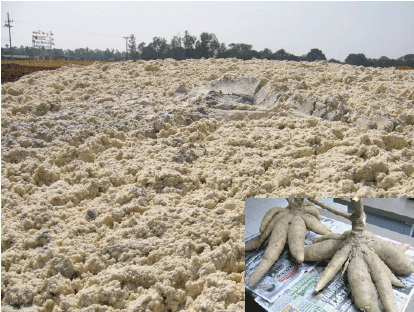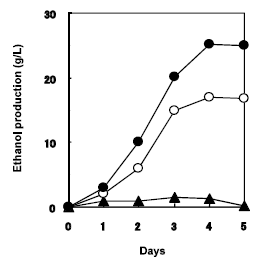Development of effective ethanol production technology using cassava pulp
Description
To resolve global warming issues caused by greenhouse gases, biomass-derived fuels (biofuels) are likely to have a future as a replacement for fossil fuel-based energy. Biomass fuels are “carbon neutral,” meaning that they do not add to of the sum total of carbon dioxide in the atmosphere. Ethanol is increasingly being used as a substitute for fossil fuels in the transportation sector. At present, fuel ethanol production chiefly depends on the utilization of sugar cane juice and cornstarch from agricultural crops. However, a dramatic increase in ethanol production using the above crops may not be practical in the near future, since sugarcane and corn production for ethanol will compete for limited agricultural land needed for food and feed production. Therefore, a potential source for low-cost ethanol production and agricultural sustainability is needed to utilize agricultural wastes that are composed of starchy and cellulosic complex materials.
Cassava (Manihot esculenta Crantz), which contains high levels of starch, is widely cultivated in tropical areas. In Thailand, cassava starch production is a large and growing industry, with about 10 million tons of fresh cassava tubers used annually. When starch is extracted from cassava tubers in the tapioca starch industry process, grated cassava tubers are separated into starch granules and fibrous residual materials by centrifugation following water extraction. The fibrous residual materials, termed cassava pulp, constitute around 30% of the original tubers as solid waste (Fig. 1). Cassava pulp thus has potential for use as a carbohydrate resource to replace the use of starch in tapioca, sugarcane, corn, and other grains that are currently harvested for ethanol production. In spite of this huge potential, the chief usages of large quantities of cassava pulp have been limited to lowvalue animal feed and fertilizer. To effectively utilize cassava pulp, we experimented with converting its components to ethanol by employing a sake-brewing yeast strain displaying glucoamylase on its cell surfaces. A Saccharomyces cerevisiae Kyokai No. 7 (K7) strain displaying Rhizopus oryzae glucoamylase (K7G) was constructed using the C-terminal-half region of α-agglutinin. A sample of cassava pulp was pretreated by hydrothermal reaction (140℃ for 1 h), and then by various kinds of commercially available cellulases to hydrolyze the cellulose in the sample. Strain K7G fermented the pretreated sample very effectively and produced ethanol at high yields: 98 and 92% of the theoretical value at 5 and 10%, respectively, of the substrate (Fig. 2). The ethanol yield and productivity are almost the same as the results obtained when strain K7 is used to ferment cassava pulp pretreated with cellulase plus amylase, indicating the effectiveness of arming yeasts displaying hydrolytic enzymes in producing ethanol using cassava pulp. We are now constructing a yeast strain codisplaying three types of cellulases and two types of amylases to fully utilize cassava pulp and directly produce ethanol without the addition of any enzymes.
Figure, table
-
Fig. 1. Discarded cassava pulp at starch factory in Thailand. Cassava tubers (bottom right corner). -
Fig. 2. Fermentation profile of cassava pulp using sake yeast strain K7G displaying glucoamylase
Symbols represent 5% cassava pulp (open circles) and 10% cassava pulp (closed circles). Closed triangles indicate control strain K7.
- Affiliation
-
Japan International Research Center for Agricultural Sciences Post-harvest Science and Technology Division
- Classification
-
Technical A
- Term of research
-
FY2006(FY2006~2010)
- Responsible researcher
-
KOSUGI Akihiko ( Post-harvest Science and Technology Division )
KONDO Akihiko ( Kobe University )
UEDA Mitsuyoshi ( Kyoto University )
MURATA Yoshinori ( Post-harvest Science and Technology Division )
VAITHANOMSAT Pilanee ( Agro-Industrial Product Improvement Institute, Kasetsart University, Thailand )
THANAPASE Warunee ( Agro-Industrial Product Improvement Institute, Kasetsart University, Thailand )
MORI Yutaka ( Post-harvest Science and Technology Division )
- ほか
- Publication, etc.
-
KOSUGI, A. (2005) New Energy and Industrial Technology Development Organization (http://www.nedo.go.jp/itd/fesendo/h17/gaiyou/theme10.html).
A. Kosugi, A. Kondo, M. Ueda, Y. Murata, P. Vaithanomsat, W. Thanapase and Y. Mori. (2006): Ethanol Production from Cassava Wastes Using a Surface-Engineered Yeast Strain Displaying Glucoamylase.Abstracts of the Annual Meeting of the Energy Society of Japan 3rd, 112.
- Japanese PDF


